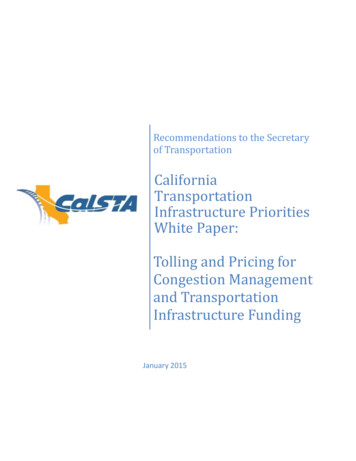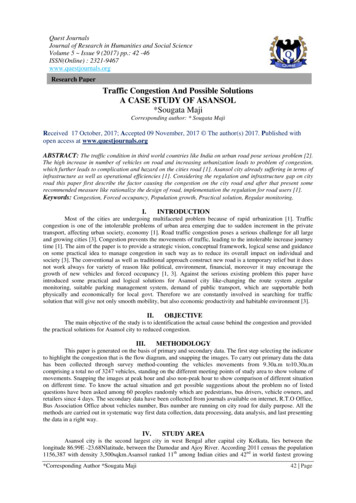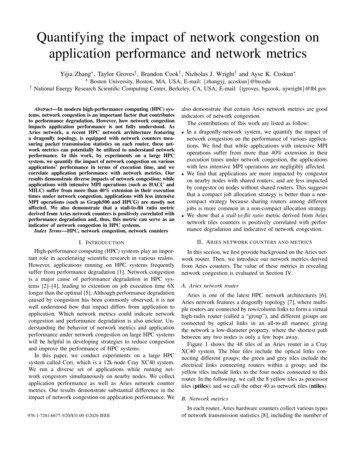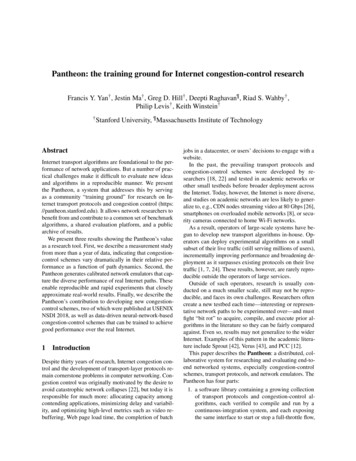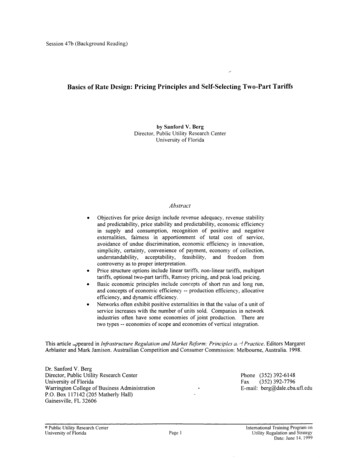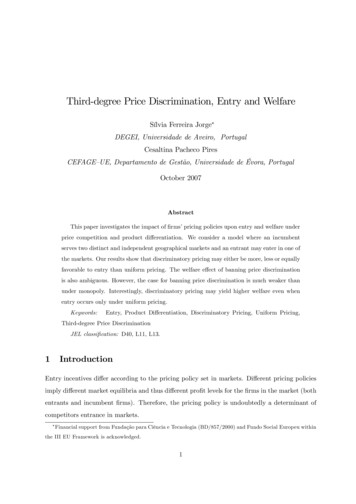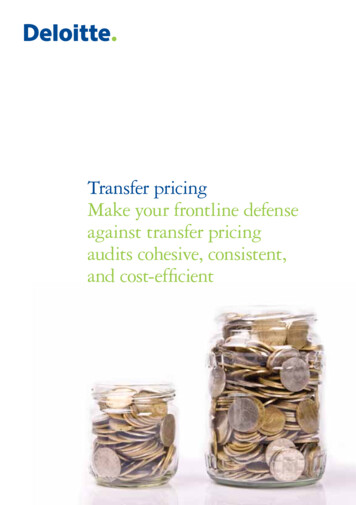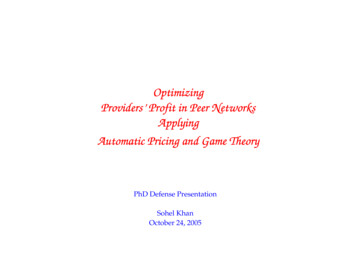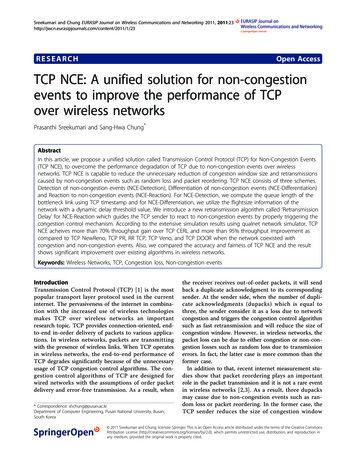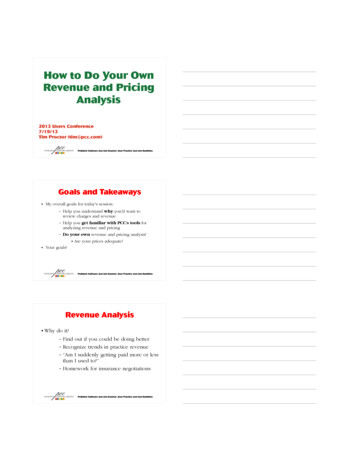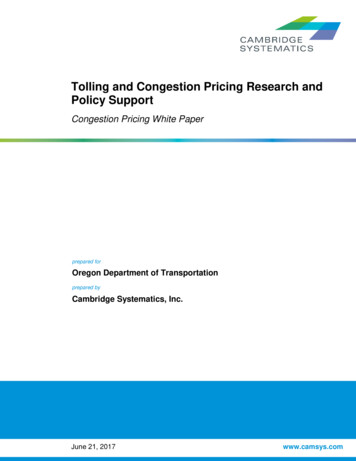
Transcription
Tolling and Congestion Pricing Research andPolicy SupportCongestion Pricing White Paperprepared forOregon Department of Transportationprepared byCambridge Systematics, Inc.June 21, 2017www.camsys.com
reportTolling and Congestion PricingResearch and Policy SupportCongestion Pricing White Paperprepared forOregon Department of Transportationprepared byCambridge Systematics, Inc.555 12th Street, Suite 1600Oakland, CA 94607dateJune 21, 2017
Tolling and Congestion Pricing Research and Policy SupportTable of ContentsExecutive Summary.ES-1Tolling .ES-1Congestion Pricing .ES-1Federal and State Laws .ES-2Applications of Tolling .ES-3Major Considerations and Issues .ES-51.0 Introduction . 12.0 Applications of Tolling . 22.1 Tolling Types . 22.1.1 High Occupancy Toll Lanes . 32.1.2 Cordon Pricing . 42.1.3 Open-Road Tolling (ORT). 52.1.4 Mileage Base Pricing or Vehicle Miles Traveled Tolling .63.0 Tolling Authorization . 83.1 Federal Requirements . 8Mainstream Tolling Programs . 8Toll Pilot Programs. 93.2 State Legislative Authority to Toll .114.0 Policy Implications for Tolling .134.1 Revenue Generation .144.2 Congestion Reduction .154.3 Equity and Environmental Justice .164.4 Privacy Issues .174.5 Efficiency and Administrative Costs .174.6 Rural versus Urban .184.7 Public Acceptance .194.8 Diversion .205.0 Congestion Pricing Case Studies .215.1 Puget Sound Region, Washington .215.2 Dallas / Fort Worth, Texas .25Cambridge Systematics, Inc.i
Tolling and Congestion Pricing Research and Policy SupportList of TablesTable 1 Key Components of Mileage Based Pricing . 7Table 2 Tolling and Toll Way References in Oregon Revised Statutes .12Table 3 Ability of Tolling to Achieve Congestion Management Objectives .15Table 4 I-405 Performance Metrics .24Cambridge Systematics, Inc.iii
Tolling and Congestion Pricing Research and Policy SupportExecutive SummaryThis Executive Summary provides an overview of the most feasible types of tolling applications anddescribes the technological, financial, political, and social tradeoffs between tolling, current funding methods,and the different applications of tolling. Included is an overview of tolling, how it relates to congestion pricing,the Federal and state authorization of tolling, an overview of four types of tolls, and the major considerationsand issues for implementing tolls. The attached white paper provides more detailed descriptions of tollingmethods, trade-offs and case studies.Tolling as a Potential Funding SourceTolling involves charging a direct fee to a vehicle for using a highway, bridge or tunnel. Tolls were historicallyimplemented to help recoup the cost of road construction or maintenance and to divert vehicles from usingcongested roadways. Tolling differs from fuel taxes as a funding source because tolls may be applied to aspecific facility (road segment, bridge, or area). When tolls are used to change travel demand for that facilityby charging higher tolls during peak travel, the term congestion pricing is often used.TollingCongestion PricingA toll system allows drivers to access a public orprivate roadway for a fee (or toll) and is a form ofroad pricing typically implemented to help recoupthe cost of road construction or maintenance. A tollroad should have adequate traffic willing to pay ahigh enough toll to address construction, maintenance, and toll collection costs to be financiallyfeasible. Tolling is a flexible funding mechanismthat can be used as part of a congestion pricingstrategy, with the potential of reducing congestionand optimizing performance.Congestion pricing, or value pricing, managesdemand by applying higher charges during peakperiods or more congested conditions for use of theroadway. This pricing strategy can reducecongestion without adding capacity to the roadwaysbecause more price sensitive drivers shift theirtravel during rush hour to less congested times,other routes or different transportation modes, ordecide not to make the trip. Removing a smallpercentage of vehicles from the congestedroadways enables the system to function muchmore efficiently. There are four main types ofcongestion pricing strategies as shown in Table 1:Table 1.Congestion Pricing StrategiesVariably Priced LanesCordon ChargesVariable tolls charged to use separated lanes within ahighway, such as express toll lanes or high occupancytoll (HOT) lanesEither variable or fixed charges to drive within or into acongested areaVariable Tolls on Entire RoadwaysAreawide ChargesPricing strategy that changes toll rates on toll roadsaccording to a variable schedule. Toll rates are higherduring peak travel hours, encouraging motorists to usethe roadway during less congested periods.Per-mile charges on all roads within an area that mayvary by level of congestionCambridge Systematics, Inc.ES-1
Tolling and Congestion Pricing Research and Policy SupportFederal and State LawsThere are four Federal programs that allow tolling to support highway construction activities as well as tofacilitate road pricing strategies for congestion management. Two “mainstream” Federal programs include:Section 129, which details the permitting of new tolls, and Section 166, which discusses High-OccupancyToll (HOT) and High-Occupancy Vehicle (HOV) Lanes. Tolls can also be implemented under the InterstateSystem Reconstruction and Rehabilitation Pilot Program (ISRRPP) and Value Pricing Pilot Program (VPPP).In Oregon, state law stipulates that the Oregon Transportation Commission has legal authority to establishtoll roads and toll lanes, and there are no state imposed restrictions on cities or counties implementing atolling system on locally managed roads (383.004).Toll revenue collected in Oregon is restricted to the requirements outlined in the Oregon ConstitutionArticle IX, section 3a, which requires the use of revenue to be used exclusively for the construction,reconstruction, improvement, repair maintenance, operation and use of public highways, roads, streets, androadside rest areas in Oregon. 11Oregon State Legislature. Oregon Constitution 2016 Edition.https://www.oregonlegislature.gov/bills laws/Pages/OrConst.aspxCambridge Systematics, Inc.ES-2
Tolling and Congestion Pricing Research and Policy SupportApplications of TollingHigh-Occupancy Toll (HOT) LanesHOT lanes allow vehicles with few or no passengers to pay a toll to use HOV lanes,which have excess capacity and allow vehicles to bypass congestion. HOT lanesare typically created by converting an HOV lane to a HOT lane. The toll price canchange by time of day or be set dynamically based on traffic levels. Tollsgenerated from HOT lanes can be used to supplement the construction,operations, enforcement, and maintenance costs of the lanes. Variable pricingkeeps lanes free of congestion and helps ensure reliable travel times. There aremore than 20 HOT lanes operating in a dozen states nationwide, with more poisedto open.Benefits and Drawbacks “FasTrak High Occupancy toll lanes along interstate 15” byChevy 111, under CC BY / cropped from originalEase of Implementation Historical experienceHelp fund new lane onhighwayAn existing HOV systembehelpfulincanestablishing HOT lanes Roadway Efficiency: HOT lanes increase the traffic flow for all lanes,allowing more cars to utilize the roadway, and also have the potential toprovide faster and more reliable travel times.Revenue Generation: Revenue is generated from HOT lanes, which can beused for maintenance and operations.Equity Implications: Initially, equity concerns were raised, with peopleassuming only high-income households would use the HOT lanes. However,rigorous research has shown that low-income drivers are not disproportionallyaffected.Open-Road Tolling (ORT)ORT is often deployed across a large network of roadways spanning large regions.Within ORT, tolls can be implemented on bridges and tunnels. Tolls are eithercollected with an electronic transponder (ETC) or through license plate recognitiontechnology. This allows vehicles to drive through the toll plaza at highway speeds,decreasing congestion at these check points, while collecting the toll. ORT is foundthroughout the United States, from the E-ZPass network in the Midwest andNortheast, SunPass in Florida, to Good To Go! In Washington.Benefits and Drawbacks Ease of Implementation Several states haveimplemented ORTEaseof Implementationthroughout the U.S.Historicalexperience SeveralstateshaveORT implementedHelp fund newlane onthroughouttheU.S.highway Safety: Research shows that ORT eliminates stop-and-go traffic, improvingoperations and reducing exposure to crashes.Speed and Roadway Capacity: ORT, along with congestion pricing,improves speed and increases traffic flow.Economic Benefits: The travel time savings results in direct, indirect, andinduced economic benefits, including lower fuel consumption, shortercommutes, and larger labor pools.Toll Agency Costs: The cost of deploying and sustaining this program canbe high, though technological advances are decreasing cost.User Costs: Most systems require motorists to buy or rent transponders. An existing HOV systemwould be helpful inestablishing HOT lanesCambridge Systematics, Inc.ES-3
Tolling and Congestion Pricing Research and Policy SupportCordon PricingCordon pricing establishes a fee to enter a specified area, usually a city’sdowntown or business district, to mitigate intense congestion. This fee can varyby time of day, encouraging drivers to use alternative modes or travel during aless congested time, or be at a fixed price. This method has been implementedin Singapore, London, Stockholm, and Gothenburg and has yet to be employedin the United States.Benefits and Drawbacks“Electronic Road Pricing” by VK35, used under CC BY /cropped from original.Ease of Implementation Not yet implemented in theU.S. Implemented andsuccessful in Singapore,London, Stockholm, &Gothenburg Decreased Congestion and Improved Livability: With fewer vehicles in adense urban area, congestion decreases while improving livability factors suchas decreased pollution, noise, and traffic collisions. Revenue Generation:Cordon pricing yields substantial and reliablerevenues. Local Businesses: Some shopping trips are sensitive to cordon pricing, withsome drivers opting to shop in areas outside the priced zone. However,research is still inconclusive about the overall impact. Administrative Cost and Implementation: The cost of deploying andsustaining this program can be high, ranging from 48 percent (in London) to 7percent (in Singapore) of total annual toll revenue.Mileage-Based PricingMileage-based pricing involves charging vehicles a per-mile toll, essentiallycharging a higher fee to drivers who use the system more frequently. Revenuesfrom this toll are an alternative to taxes on fuel consumption, removing the loss ofrevenue from changes in fuel economy and fuel type. Tolling may be collectedby odometers or GPS transponders. One example of this toll is the OReGOProgram.Benefits and Drawbackswww.myorego.orgEase of Implementation Several pilots underwayin the U.S., includingOReGO System has not beenofficially launched in anyU.S. city Stable Revenue Stream: Unlike traditional taxes on gasoline, this revenuestream is not affected by changes in fuel economy. Reduced Traffic Congestion: Traffic congestion could decrease if the permile charge changes based on time of day and travel locations. Concern on Personal Privacy: Mileage-based pricing tolling can triggerpublic concerns regarding personal privacy, such as using a GPS device totrack vehicle movement. However, privacy concerns related to GPS trackingmay be declining as the prevalence of smart phones rises.Cambridge Systematics, Inc.ES-4
Tolling and Congestion Pricing Research and Policy SupportMajor Considerations and IssuesThe policy implications for tolling, as with any other funding source, consider a wide range of topics andconsiderations. Below is a quick overview of considerations in regards to tolling, with more information andbackground provided in the attached white paper.Diversion / Traffic Impacts For a new toll road, diversion can be significant if there isan easy, non-tolled, alternative route near the toll facility.Diversion can also be to transit or forgoing a tripaltogether.A new toll lane could increase congestion and degradereliability on surrounding, un-tolled facilities.Equity Initial concerns that low-income drivers would beadversely affected; however, a wide range of incomegroups choose to use toll lanes when being on timematters to them.Improving transit service as tolls are added can offset theeffects of the toll on lower income populations.Congestion and GHG Reduction Decreased congestion can lead to lower greenhouse gas(GHG) emissions and pollution.Toll roads can serve a dual purpose – they generate afunding source and if they are administered usingvariable pricing, have the ability to manage demand.Privacy Electric tolling systems require users to agree to havetheir location information logged.Agencies have methods to protect privacy and canprovide alternatives, such as paying with cash.Younger generations are less concerned about privacy.Exemptions Revenue GenerationCertain users, such as motorcycles, public transportationvehicles, and active emergency responders, are oftenexempt from tolls.Providing too many exemptions can cause the pricedlanes to become congested or lead to reduced revenuegeneration. Enforcement Fuel tax revenues are projected to decline in the future.Tolling can be seen as a more aggressive indexing toinflation.Tolling is frequently used to leverage private investmentin public-private partnerships (PPP).Administrative EffectivenessStates are sharing information on toll violators, includingblocking a vehicle registration in an outside state.Enforcement can be achieved with technology, includingcameras, and/or with visual inspection. The administrative cost of tolling includes back-endaccounting and enforcement. Automation of collectingtolls and the expanding number of retail outlets forobtaining transponders has decreased costs.Comprehensive customer service, outreach andeducation help ensure the success of tolling programs.Public Acceptance 1States that have implemented variable pricing strategiesshow public support reaches 50-60% once motoristsexperience positive benefits of more reliable traveltimes.1Different factors affect how the public accepts tolls androad pricing, including the use of tolling revenues, andthe type of tolling application.Washington State Department of Transportation. Pricing Acceptance Public Opinion Analysis. 011/05/24/Appendix A Public Opinion Analysis web.pdfCambridge Systematics, Inc.ES-5
Tolling and Congestion Pricing Research and Policy Support1.0 IntroductionBeginning in 2007, the Oregon Transportation Commission conducted extensive research, evaluation, andpublic outreach focused on understanding the feasibility of tolling within the state. This work produced thefollowing seven white papers completed in February 2009:1.Air Quality/Greenhouse Gas Emissions White Paper (PDF) - Highlights (PDF)2.Geographic and Situational Limits White Paper (PDF) - Highlights (PDF)3.Travel Demand Model Sufficiency White Paper (PDF) - Highlights (PDF)4.Economic Evaluation of Improved Reliability White Paper (PDF) - Highlights (PDF)5.Assessing the Economic Effects of Congestion Pricing White Paper (PDF) - Highlights (PDF)6.Economic Comparison of Alternatives White Paper (PDF) - Highlights (PDF)7.Truck-Only Toll Lanes White Paper (PDF) - Highlights (PDF)This white paper updates some information in these 2009 papers and is intended as a primer to inform policymakers on the most feasible types of tolling applications. It describes the technological, financial, political,and social trade-offs between tolling and current funding methods and different applications of tolling. Thispaper also describes how the State Legislature could use tolling on Oregon roadways and bridges to pay foradditional roadway capacity in congested corridors. Following this brief introduction, the following foursections lay out what tolling options the State could deploy to generate revenues or reduce congestion,statutory authorization within Oregon, policy implications of tolling, and two case studies.2.0 Applications of Tolling: This section defines four major tolling applications and evaluates their mostsignificant benefits and costs. Provided are examples of where these tolling applications have beendeployed and how they could be implemented in Oregon.3.0 Tolling Authorization: This section describes the four Federal programs the Federal HighwayAdministration (FHWA) has maintained to support tolling initiatives into the Fixing America’s SurfaceTransportation Act (FAST Act) and summarizes the requirements of each program. This includes theInterstate System Reconstruction and Rehabilitation Pilot Program (ISRRPP), which ODOT may apply for,and the Value Pricing Pilot Program (VPPP), in which Oregon maintains a spot. Oregon’s legislativeauthority to toll is also summarized.4.0 Policy Implications for Tolling: This section explains the most likely issues and trade-offs fromtolling and how the various applications perform compared to current funding sources with regard to eightof the most significant policy issues: (1) revenue generation, (2) congestion reduction, (3) equity andenvironmental justice, (4) privacy, (5) administrative effectiveness, (6) rural versus urban impacts, (7)diversion, and (8) public acceptance.5.0 Congestion Pricing Case Studies: This section describes two regions, Puget Sound, Washingtonand Dallas, Texas, which have successfully implemented tolling as a revenue generating mechanism tofund the construction of tolling facilities and other regionally significant transportation projects andimprovements.Cambridge Systematics, Inc.1
Tolling and Congestion Pricing Research and Policy Support2.0 Applications of Tolling2.1 Tolling TypesThis section evaluates the menu of tolling applications as well as their benefits and costs. A toll is a feecharged by the operator of a highway, bridge, or tunnel for use of that facility. All types of tolling assess a feeon vehicles on public or private roadways and are typically implemented to help recoup the cost of roadconstruction or maintenance. Traditional tolling applications have been deployed in 35 cities throughout theUnited States, including two states on the West Coast: Washington and California. 2 Open road tolling (ORT)is an electronic toll system without physical toll plazas, where motorists are charged while driving. The stateof New Hampshire implemented ORT beginning in May 2010. The state of New York will implement ORT onall Metropolitan Transportation Authority (MTA) operated bridges and tunnels in the New York metropolitanregion by the end of 2017. 3Congestion pricing, or value pricing, manages demand by applying higher charges during peak periods ormore congested conditions for use of the roadway. This pricing strategy reduces congestion without addingcapacity to the roadways because more price sensitive drivers shift their travel during rush hour to lesscongested times, routes or transportation modes. Removing a small percentage of vehicles from thecongested roadways enables the system to function much more efficiently.There are four main types of congestion pricing strategies: Variable priced lanes: tolls rates that vary by time of day on separated lanes within a highway, such asexpress toll lanes or high-occupancy toll (HOT) lanes Variable tolls on entire roadways: tolls that vary by time of day, both on toll roads and bridges, as wellas on existing toll-free facilities during rush hours Cordon charges: either variable rate or fixed charges to drive within or into a congested area of a city Vehicle miles of travel (VMT) charges: per-mile charges that may vary by level of congestion on allroads within an area.For the general public and most elected officials, the first and most significant distinction of these tollsinvolves understanding the differences of funding transportation with generic taxes versus user fees. Thisdifference is complex because many types of fees are sometimes called taxes: gas tax, carbon tax,weight-mile tax, vehicle excise tax, studded tire tax, bicycle excise tax, etc. The most straightforwarddistinction classifies any charge to a transportation user as a user fee (e.g., studded tire tax), and anyfunding source collected from a non-transportation activity, such as a payroll tax dedicated to transportation,as a tax, regardless of how the money is eventually spent. This distinction is important when consideringany applications of tolling, because all forms of tolling are user fees when the objective of user fees are toassign the burden of paying for transportation improvements and maintenance to the users of transportation.2International Bridge, Tunnel and Turnpike Association (IBTTA). 2015 Report on Tolling in the United nts/MAF/2015 FactsInBrief Final.pdf3New York State. 2017. Governor Cuomo Announces Open Road Tolling to be completed on All MTA Bridges and Tunnels in a-bridges-and-tunnels-2017Cambridge Systematics, Inc.2
Tolling and Congestion Pricing Research and Policy SupportThis assignment means the fee sends a user a price signal, which can be weak, in the case of fuel taxes, orstrong, in the case of congestion pricing.2.1.1 High Occupancy Toll LanesHigh-occupancy toll lanes allow vehicles not meeting occupancy requirements, such as vehicles with fewerthan three riders including single-occupancy vehicles (SOV), to pay a toll to use high-occupancy vehicle(HOV) lanes which have excess capacity. The toll changes price by time of day or dynamically depending ontraffic levels, and funds are collected electronically. Variable pricing (i.e., congestion pricing) is a criticalcomponent to HOT lanes as it keeps the lanes free flowing and ensures reliable performance when in use.Many HOT lanes only operate during the AM and PM peak periods, when congestion is highest. There aremore than 20 HOT lanes operating in a dozen states nationwide, including the cities of Seattle (SR 167 HOTLane), San Francisco (Bay Area Express Lanes), and San Diego (I-15) with more poised to open.The benefits of HOT lanes include: Reliable and Faster Travel Times. HOT lanes have the potential to provide faster and more reliabletravel times to drivers by shifting paying drivers to underutilized and uncongested carpool lanes. If amotorist has an important meeting or appointment, he or she can pay a fee to make their trip on time andexperience a more predictable trip in an uncongested carpool lane. Roadway Efficiency. HOT lanes increase a roadway’s throughput (person-trips). Through variablepricing and lane management, actively managed HOT lanes divert just enough SOVs out of the mixedflow lanes to increase the capacity of the mixed flow lanes while still allowing the HOV lanes to operateat maximum efficiency. Revenue Generation. HOT lanes generate toll revenue from SOVs. Toll revenue provides revenues thatmay fund the operation, maintenance, enforcement of the HOT lane, and in one example generatesfunding which is spent on express bus service using the lane (e.g., express bus service on San Diego I15). However, constitutional restrictions prevent revenue collected from tolling from being spent ontransit improvements in the State of Oregon. 4The costs and disbenefits include: Equity Implications. HOT lanes users were initially expected to be primarily high income travelers.While frequent users of HOT lanes tend to have higher incomes than other commuters, more rigorousresearch of specific corridors has revealed a majority of vehicles are driven by contractors who mustreach their job-sites at the start of their work day (e.g., SR-91 in Orange County). 5 Most HOT lanes havea cap that restricts the maximum toll regardless of congestion, but some, such as the I-10 in LosAngeles, have activated HOV-only restrictions, prohibiting SOV use when speeds in the HOT lane fallbelow 45 miles per hour. 6 Nevertheless, HOT lane operators are expecting over the long term that the4FHWA. 2003. A Guide for HOT Lane Development.https://ntl.bts.gov/lib/jpodocs/repts te/13668 files/chapter 1.htm5RAND Corporation. 2009. Equity and Congestion technical reports/2009/RAND TR680.pdf, Los Angeles Magazine, June 11, -new-name-for-lexus-lanes/6Daily Breeze. 2016. 110, 10 Freeway Express Lanes Are Slowing Down and Officials Aren’t Sure of the d-officials-arent-sure-of-thefixCambridge Systematics, Inc.3
Tolling and Congestion Pricing Research and Policy Supportincreasing congestion and popularity of HOT lanes will require policy makers to increase toll subsidiesfor low income drives.2.1.2 Cordon PricingCordon pricing is a form of congestion pricing that is implemented in dense urban areas or congested activitycenters. The fee to enter the specified area defined by a cordon can vary by time of day (i.e., congestionpricing) or be set at a flat rate. The fee charges vehicles that travel into a specified area, such as a downtownor business district. Prices to enter the area may be adjusted throughout the day, reducing congestion byencouraging motorists to use alternative modes or to travel during a less congested time. Cordon pricingusually exempts residents living inside the cordon. In the United States Cordon Pricing has not beenpermanently implemented. However in 2007, Mayor Bloomberg of New York City introduced a congestionpricing plan that would cordon a district in Manhattan and impose a charge on all private automobiles thattraveled into the area. The plan did not receive the necessary political support from the State Legislature orthe Governor due to concerns regarding adequat
There are four main types of congestion pricing strategies as shown in Table 1: Table 1. Congestion Pricing Strategies Variably Priced Lanes Cordon Charges Variable tolls charged to use separated lanes within a highway, such as xpress e toll lanes or high occupancy toll (HOT) lanes
